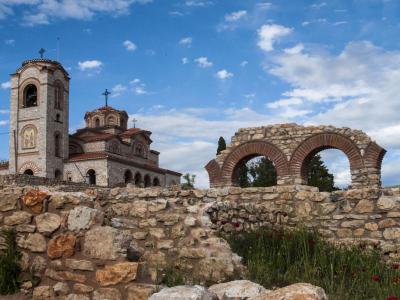Plaošnik Archaeological Site, Ohrid (must see)
Barely 825 feet downhill from Samoil's Fortress on Ohrid hill is the Plaosnik Archeological Site, an ongoing excavation and research site of early Lychnidos, aka Ohrid. The main find on the site is the church built by Saint Clement in 893. The church was built on the foundation of an earlier Christian basilica.
The early basilica was dedicated to the legendary 4th century martyr, Saint Panteleimon, whose name means "All-merciful." The Ohrid Literary School was founded on this site by Saint Clement in the 9th century. The school became the leading center of Slavic culture. Saint Clement was buried in this church in a tomb built by himself.
Under Ottoman rule, Saint Clement's was converted into a mosque called the Imaret Mosque. The mosque was a memorial by Sinan Chelebi of the prestigious Turkish family of Ohrizade. The remains of the mosque were relocated in 2000. It had been covering the earlier Christian church and basilica.
Discoveries as of 2007 include the baptistery of the five aisled basilica. There are mosaic tiled mosaic floors dated from the 4th to 6th centuries. The mosaics show forms of fanciful animals, curvilinear geometrics, and swastikas as symbols of a nourishing sun. In 2007, 2,383 Venetian coins were discovered, linking Venice and Ohrid in trade.
The early basilica was dedicated to the legendary 4th century martyr, Saint Panteleimon, whose name means "All-merciful." The Ohrid Literary School was founded on this site by Saint Clement in the 9th century. The school became the leading center of Slavic culture. Saint Clement was buried in this church in a tomb built by himself.
Under Ottoman rule, Saint Clement's was converted into a mosque called the Imaret Mosque. The mosque was a memorial by Sinan Chelebi of the prestigious Turkish family of Ohrizade. The remains of the mosque were relocated in 2000. It had been covering the earlier Christian church and basilica.
Discoveries as of 2007 include the baptistery of the five aisled basilica. There are mosaic tiled mosaic floors dated from the 4th to 6th centuries. The mosaics show forms of fanciful animals, curvilinear geometrics, and swastikas as symbols of a nourishing sun. In 2007, 2,383 Venetian coins were discovered, linking Venice and Ohrid in trade.
Want to visit this sight? Check out these Self-Guided Walking Tours in Ohrid. Alternatively, you can download the mobile app "GPSmyCity: Walks in 1K+ Cities" from Apple App Store or Google Play Store. The app turns your mobile device to a personal tour guide and it works offline, so no data plan is needed when traveling abroad.
Plaošnik Archaeological Site on Map
Sight Name: Plaošnik Archaeological Site
Sight Location: Ohrid, North Macedonia (See walking tours in Ohrid)
Sight Type: Attraction/Landmark
Guide(s) Containing This Sight:
Sight Location: Ohrid, North Macedonia (See walking tours in Ohrid)
Sight Type: Attraction/Landmark
Guide(s) Containing This Sight:
Walking Tours in Ohrid, North Macedonia
Create Your Own Walk in Ohrid
Creating your own self-guided walk in Ohrid is easy and fun. Choose the city attractions that you want to see and a walk route map will be created just for you. You can even set your hotel as the start point of the walk.
Ohrid's Historical Churches
According to the legend based on the observations of 15th-century Ottoman traveler Evlia Celebia, the town of Ohrid used to have within its boundaries 365 chapels – one for every day of the year. At some point during Medieval times, Ohrid was even dubbed Slavic Jerusalem. Today, although the number of churches is considerably smaller, the architectural and historical value of those that remain... view more
Tour Duration: 1 Hour(s)
Travel Distance: 2.7 Km or 1.7 Miles
Tour Duration: 1 Hour(s)
Travel Distance: 2.7 Km or 1.7 Miles
Ohrid Introduction Walking Tour
Ohrid was called "Lychnidos", meaning "City of Light." By the late 9th century, the town was referred to as "Ohrid." This is Slavic, meaning "on a hill." With its 365 churches, it was known as "Jerusalem of the Balkans."
Legend says King Cadmus, banished from Thebes, founded the town on a hill overlooking the lucid waters of Lake Ohrid. That may... view more
Tour Duration: 2 Hour(s)
Travel Distance: 2.3 Km or 1.4 Miles
Legend says King Cadmus, banished from Thebes, founded the town on a hill overlooking the lucid waters of Lake Ohrid. That may... view more
Tour Duration: 2 Hour(s)
Travel Distance: 2.3 Km or 1.4 Miles





